Theodore II Doukas Laskaris or Ducas Lascaris was Emperor of Nicaea from 1254 to 1258. He was the only child of Emperor John III Doukas Vatatzes and Empress Irene Laskarina. His mother was the eldest daughter of Theodore I Laskaris, who had established the Empire of Nicaea as a successor state to the Byzantine Empire in Asia Minor after the crusaders captured the Byzantine capital, Constantinople, during the Fourth Crusade in 1204. Theodore received an excellent education from two renowned scholars, Nikephoros Blemmydes and George Akropolites. He made friends with young intellectuals, especially with a page of low birth, George Mouzalon. Theodore began to write treatises on theological, historical and philosophical themes in his youth.
Miniature of Theodore II from the manuscript of Georgius Pachymeres' Historia, 14th century
Ruins of the walls of Nicaea (now İznik in Turkey)
Hyperpyron of Theodore II issued during his first regnal year, depicting him alongside the Virgin Mary
Ruins of the Byzantine fortification around Dyrrachium (now Durrës in Albania)
The Empire of Nicaea or the Nicene Empire was the largest of the three Byzantine Greek rump states founded by the aristocracy of the Byzantine Empire that fled when Constantinople was occupied by Western European and Venetian armed forces during the Fourth Crusade, a military event known as the Sack of Constantinople. Like the other Byzantine rump states that formed due to the 1204 fracturing of the empire, such as the Empire of Trebizond and the Despotate of Epirus, it was a continuation of the eastern half of the Roman Empire that survived well into the medieval period. A fourth state, known in historiography as the Latin Empire, was established by an army of Crusaders and the Republic of Venice after the capture of Constantinople and the surrounding environs.
Nicaea city wall, Lefke gate; Iznik, Turkey
Coin issued by Michael VIII Palaeologus to celebrate the liberation of Constantinople from the Latin army, and the restoration of the Byzantine Empire.






